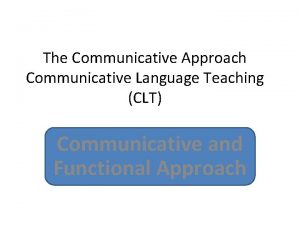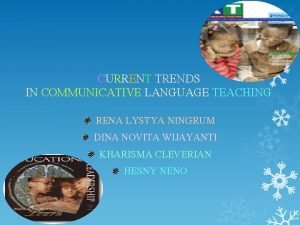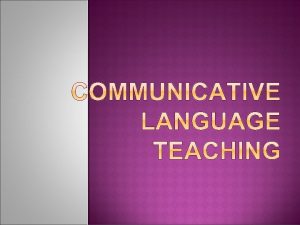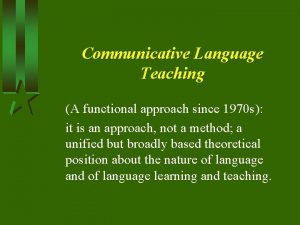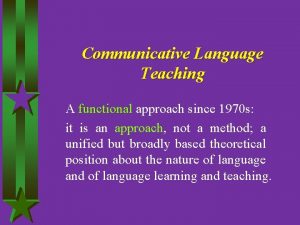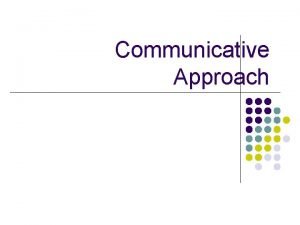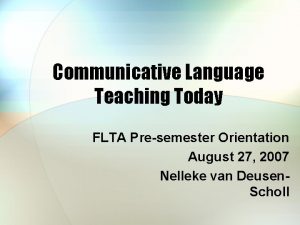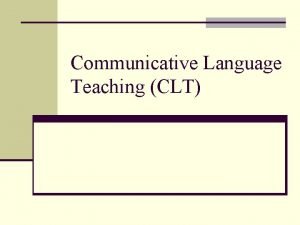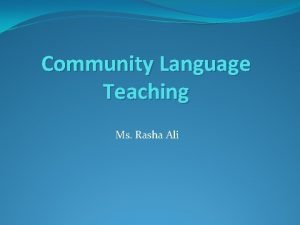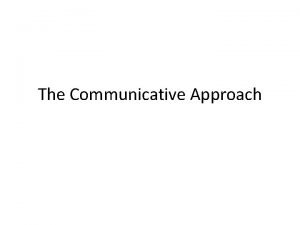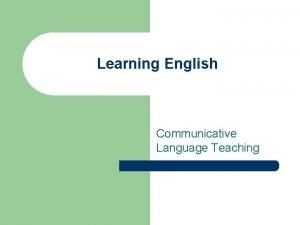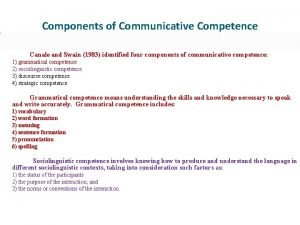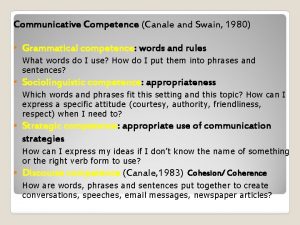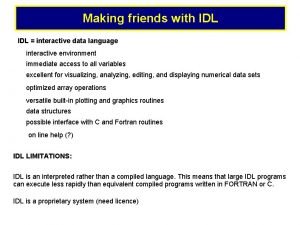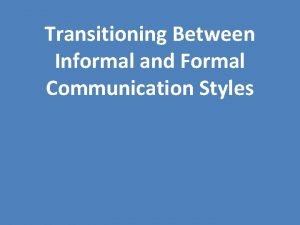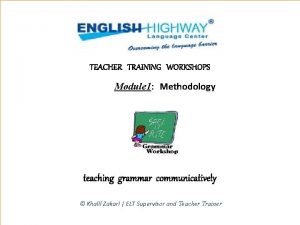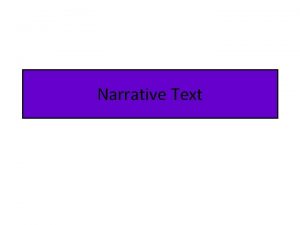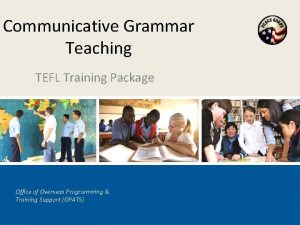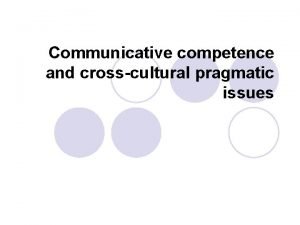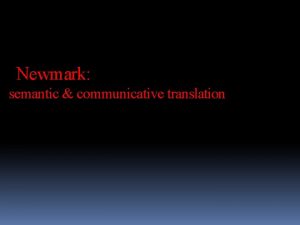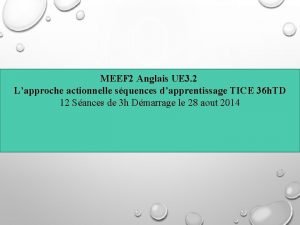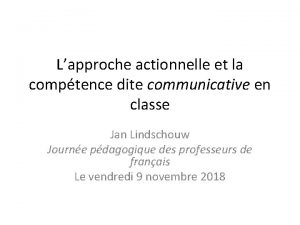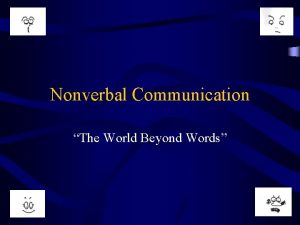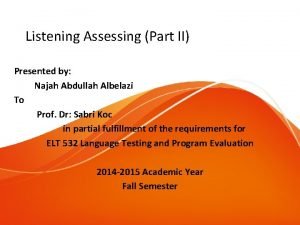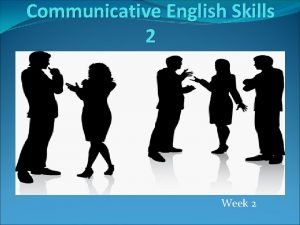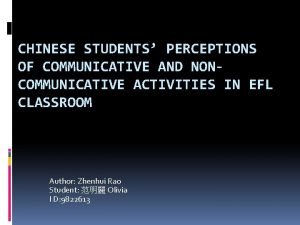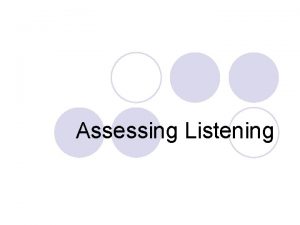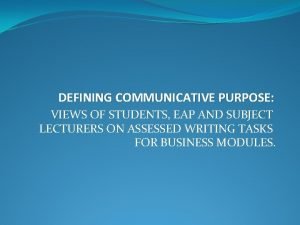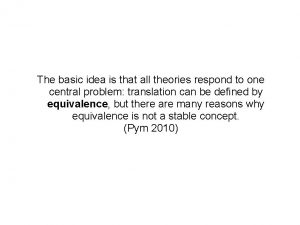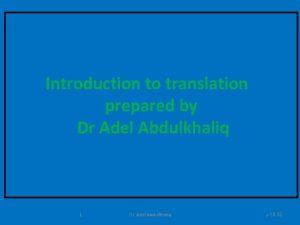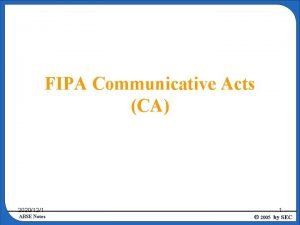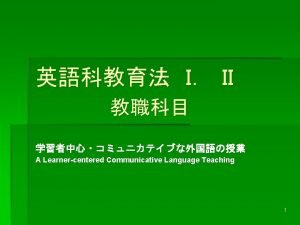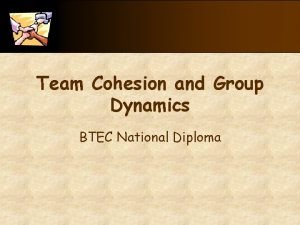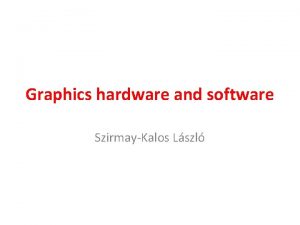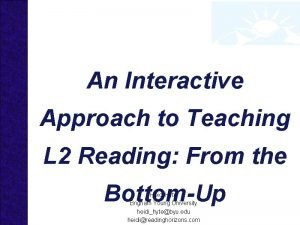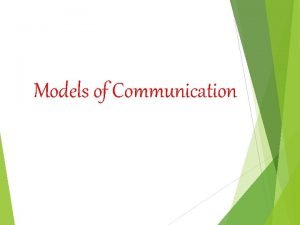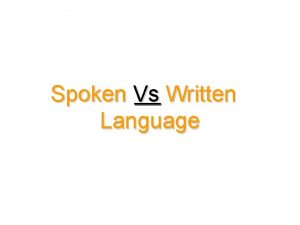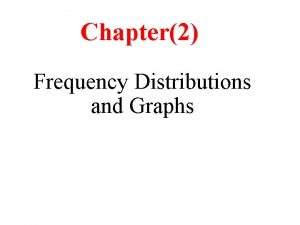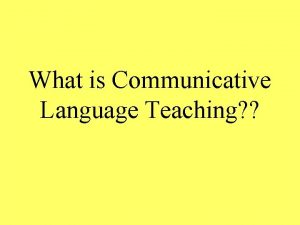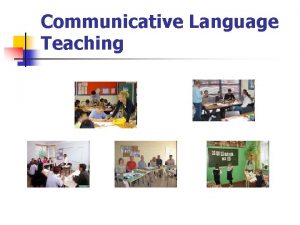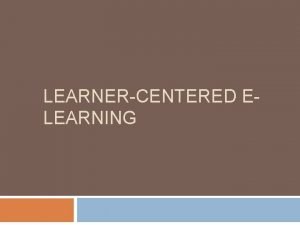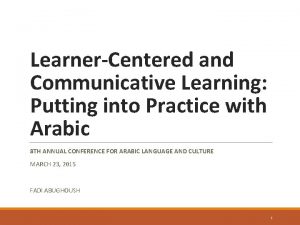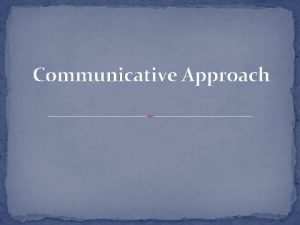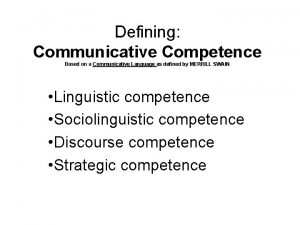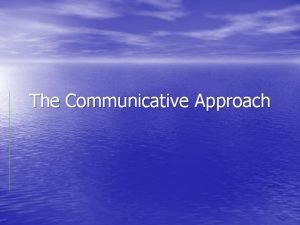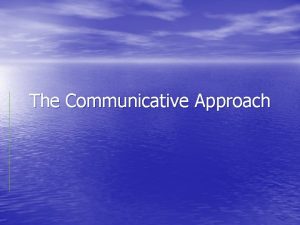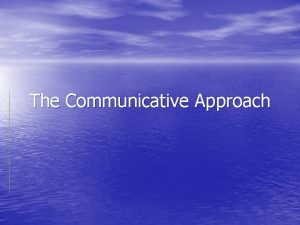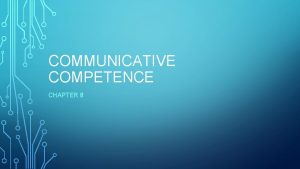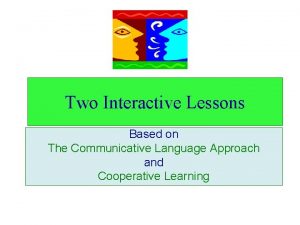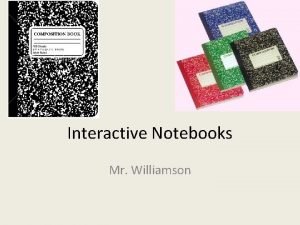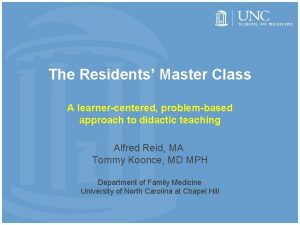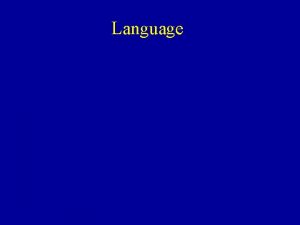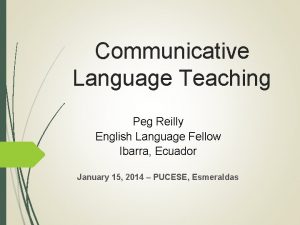A learnercentered Communicative and Interactive Language Class Language






































































- Slides: 70




A learner-centered Communicative and Interactive Language Class実現の方略 Language Home Low Affective Filter 低い情意フィルター Communicative Tasks コミュニカテイブなタスク Integrated Current Communicative Approaches 統合されたコミュニカテイブ・アプローチ 4





Real World Context 現実世界に近い言語環境 n Classroom activities should parallel the ‘real world’ as closely as possible (Widdowson 1987). 授業での活動が現実世界に近いこと n Situationaly Realistic 現実的・臨場感 n Contextually Rich 文脈が豊か n Meaningful Content 意味のある内容 n Classroom activities should parallel the ‘real world’ as closely as possible (Widdowson 1987) 9

Reading授業の発想転換 訳読法からReading Skill養成への転換 n n n n Reading in English 1 Paragraph Reading から paragraph Writing Topic Sentence (main idea) Supporting Details Concluding Sentence Vocabularies and Structures 2. Intensive Reading and Extensive Reading * Top-down Process for Reading * Bottom-up Process for Reading * Interactive Process for Reading 4 Schema Theory (background knowledge) (Formal Schemata/Content Schemata) 5 Reading Assignment for Pleasure Reading 10


Communicative Task n n n A piece of classroom work which involves learners in comprehending, manipulating, producing or interacting in the target language while their attention is principally focused on meaning rather than form. (Nunan: 1989) 学習者が目標言語で理解したり、操作したり、表現したり、相 互作用するようにしむける意味内容のある課題・仕事であり、 学習者は主として言語の形式より意味内容に注目する。 Rotating Communication, (VTR 1) Summarization and comments Logical Debate with valid evidence (VTR 2) Oral Presentation (Mini Lecture) (VTR 3) Problem-solving Discussion 12

(1) Communicative Tasks の定義 Newnan (1989) defines communicative task as a piece of classroom work which involves learners in comprehending, manipulating, producing or interacting in the target language while their attention is principally focused on meaning rather than form. Newnan (1992) Designing Tasks for the Communicative Classroom Cambridge University Press) 13


Communicative Tasks n Newnan continues that task is a piece of meaning-focused work involving learners in comprehending, producing and /or interacting in the target language, and that tasks are analyzed or categorized according to their goals, input data, activities, settings and roles. 15


1) Grammatical Competence n Grammatical competence refers to what Chomsky calls linguistic competence and what Hymes intends by what is "formally possible. " It is the domain of grammatical and lexical capacity. 17

2) Sociolinguistic Competence n Sociolinguistic competence refers to an understanding of the social context in which communication takes place, including role relationships, the shared information of the participants, and the communicative purpose for their interaction. ( Ex. It’s cold in this room) 18

3) Discourse Competence n Discourse competence refers to the interpretation of individual message elements in terms of their interconnectedness and of how meaning is represented in relationship to the entire discourse or text. n (Inference in the context) n (Reading between the lines ) 19

Discourse Analysis談話分析 n n n n n Z Harris 1952 Discourse Analysis Discourse analysis means the study of Grammar beyond the sentence. The analysis of the writer’s intention in the context, paragraph and conversation. There are some discourse principles (rules) There are some prediction and inference followed by the next words: Therefore, 議論を深める In conclusion, 結論を導く However, 反論 As a matter of fact, 実際的な例 What makes the matter worse, さらなる、悪条件 20

Discourse Analysis n n n n Ex. 1. Do not come any closer, please. = Do not come to me any further. 2. Kiss me, please. = I would like you to kiss me. 3. Who is it? = Who are you? Who is speaking? 4. Someone in. = Please do not come in. (in the public toilet) 5. There goes telephone. = Will you get the telephone? Discourse Competence It is very hot in this room, isn’t it? = Could you open the widow? The story will be different depending on the stress of the accent. 21 Tom plays football very well, too.

4) Strategic Competence n Strategic competence refers to the coping strategies that communicators employ to initiate, terminate, maintain, repair, and redirect communication. n (Non-verbal communication) 22


CLTの本質とCLTの文脈でのコミュニ ケーション能力 n 仮説理論であるCommunicative Approach の目的 to make communicative competence the n goal of language teaching n n to develop procedures for the teaching of the four language skills that acknowledge the interdependence of language and communication Richards (1986) 24


CLTと学習者中心の授業 (1997 ) states that a major impetus to the develop of learnercentered language teaching came with the advent of communicative language teaching. n A communicative view of language and language learning has become the mainstream in ELT. n Nunan 26

The principles of Communicative language Teaching (CLT) n n n * Learners learn a language through using it to communicate * Authentic and meaningful communication should be the goal of classroom activities * Fluency is an important dimension of communication. * Communication involves the integration of different language skills. * Learning is a process of creative construction and involves trial and error. Richards and Rogers (2001) 27

Integrated Communicative Approaches 提言 n 最近のコミュニカティブなアプローチを統合し、 学習者が一連のCommunicative Tasksに参 加する授業は学習者中心の授業に発展する。 n Recent EFL/ESL education is exploring the integration of current communicative approaches. n 28

Integrated Current Communicative Approaches Communicative Language Teaching Cooperative Language Learning The Natural Approach Task-Based Language Teaching Humanistic Approach Content-Based Instruction Community Language Learning Competency-Based Language Learning 29

The integration of current communicative approaches(1) n *Communicative Language Teaching (CLT) ( 目標言語を使用し communicationが目的) n *Task-based Teaching (Communicative Tasks) ( コミュニケーション中心のタスク) (Role play, improvisation, pair work, group work, peer editing, oral and written presentation, problem-solving discussion and logical debate) n n *Natural Approach and the five Hypotheses ( ナチュラル・アプローチと5つの仮説) 30

The integration of current communicative approaches (2). n n n n *Content-based Teaching (CBT) (意味内容を重視) (Logical and academic /interdisciplinary development) *Cooperative Language Learning (共同学習、 協力、不安や緊張を解消) (Brain-storming, preparation, peer editing, peerrevising and sharing) *Problem-solving Approach (Deweyの問題解決法) *Process Approach (結果より学習プロセスを重視) *Humanistic Approach (人間愛、個々の人間の尊重) 31

Integrated Current Communicative Approaches n n 1 Communicative Language Teaching 目標言語を使用し communicationが目的 n n 2 Task-Based Teaching (Communicative Tasks:コミュニケーション中心のタスク) Communication ( rotating, role play, interviewing) Drama ( improvisation) Essay Writing ( peer editing, sharing, ) Oral presentation (VTR 5) Problem-solving Discussion (VTR 4) Logical Debate 32

Integrated Current Communicative Approaches for a Learner-centered classroom n Going through these integrated current communicative approaches, naturally we can create a learner-centered classroom based on the philosophy of humanistic tradition, which argues “Learners first, learning second. ” As Richards and Rogers (2001) emphasize, “Learner engagement is a priority. 33

Integrated Current Communicative Approaches for a Learner-centered classroom n As Nunan (1997) shows, curriculum development should involve the interaction of needs analysis, goal setting, grading and sequencing of content, materials development, implementation and evaluation. We should also see how theses processes interact within a leaner-centered approaches to curriculum. 34

CLLと学習者中心の授業 Cooperative Language Learning n n n * John Deweyの影響 Cooperation in learning ( peer-tutoring and peer-monitoring) * 認知心理学の影響 Richards and Rogers (2001) state that in second language teaching, Cooperative Language Learning (CLL) has been embraced as a way of promoting communicative interaction in the classroom and is seen as an extension of the principles of Communicative Language Teaching. It is viewed as a learner-centered approach to teaching held to offer advantages over teacherfronted classroom methods. 35

CLLと学習者中心の授業 n n In language reaching its goals are: --to provide opportunities for naturalistic second language acquisition through the use of interactive pair and group activities --to provide opportunities for learners to develop successful learning and communication strategies --to enhance learner motivation and reduce leaner stress and to create ea positive affective classroom climate. (Richards and Rogers 2001: 193) 36


The Natural Approach n The Natural Approach 5つの仮説の有効性 n The Acquisition Learning Hypothesis n The Monitor Hypothesis n The Natural Order Hypothesis n The Input Hypothesis n The Affective Filter Hypothesis 38

NA 仮説 1 Acquisition-Learning Hypothesis Acquisition(習得)Learning(学習) informal “picking up” “knowledge about” Subconscious Conscious implicit explicit 39

NA 仮説2 The Natural Order Hypothesis n n n The Second Language (L 2)Acquisition models the process of the First Language(L 1) Acquisition L 2 Models L 1 The 1 st Stage: Silent Period (Only listening ) The 2 nd Stage: Simple Forms, 1 to 3 word, sentences (ex. “Teacher mine pencil”) The 3 rd Stage: Developmental Errors (as in L 1) ( ex. “Dad my foot are all wet. ”) 40

NA仮説3:The Monitor Hypothesis n Relates to Conscious Learning n (as opposed to acquisition) n Self-editor Function n Ex. “My foots are, Oh no, that’s wrong my feet are. . ” “He go to, Oh no, He goes. . ” n Seen Most Often in Adult n “Drive careful. ” n Learners and Literate Students 41

Model of Language Performance Acquired Competence monitor output 1 time to think 2 focus on form/structure 3 knowledge of rule 42

NA仮説4:The Input Hypothesis n Input Should be: n 1) Comprehensible/Interesting/Meaningful n 2) Slightly beyond the student’s current Level of Competence ( i ) ( i +1) n Input umbrella (i+1) n Student’s Current Level hand (i) 43


Input Hypothesis by Krashen A Stage n i (current level) +1 More Second Language Acquisition n More Comprehensible Input 45

Input Hypothesis What Makes Input Comprehensible? n Modeling (Situational, Realistic) n Visual Aids (Visual Context) n Pictures (New Vocabularies with Pictures) n Objects ( something to touch, experience) n Gestures (by doing, acting, moving) n Changing the way to describe and express n (paraphrasing, rephrasing) Ex. TPO VTR n 46

ナチュラル・アプローチのインプット仮 説を活用 Input Hypothesis インプットと情意フィルターの関係 n As much comprehensible input as possible must be presented. In order to lower the affective filter, student work should center on meaningful communication rather than on form; input should be interesting and so contribute to a relaxed classroom atmosphere. (Richards: 1995) n 47


仮説5: The Affective Filter Hypothesis n When the filter (fear and anxiety of learning L 2) n is lower students feel comfortable and receptive in learning in L 2 class. When the filter is up, students feel nervous and learn less in L 2 class. n 1)Students Attitude ( Positive, challenging? ) n 2) Maslow’s Hierarchy of Needs (need to learn) n 3) Classroom Atmosphere (Comfortable context) n 4) Teacher Attitude (Sensitive and Humanistic) 49

情意フィルター仮説の活用 n Affective Filter Hypothesis n Motivation. Learners with high motivation generally do better. 高いモチベーション n Self-confidence. Learners with self- confidence and a good self-image tend to be more successful. 学習者の自信 n Anxiety. Low personal anxiety and low classroom anxiety are more conductive to second language acquisition. 不安・緊張解消 50

(7)情意フィルターを低く押さへLanguage Homeを目指す Affective Filter Hypothesis n n n The Affective Filter Hypothesis from The Natural Approach The Affective Filter Hypothesis is built on research in second language acquisition, which has identified three kinds of affective or attitudinal variables related to second language acquisition. Motivation. Learners with high motivation generally do better. Self-confidence. Learners with self-confidence and a good self-image tend to be more successful. Anxiety. Low personal anxiety and low classroom anxiety are more conductive to second language acquisition. 51


Summary of The Natural Approach: Classroom Implications in NA 1) Encouragement ( 4 EN of EFL/ESL Class) n 2) Creating Low Risk Environment n 3) Concrete Experiences for Language Acquisition n 4) Use of Cues (visual aids, pictures, objects) n 5) Meaningful Input for Communicative Tasks n 6) Active Involvement n n (Cooperative and Community Language Learning) 53

Summary: The Natural Approach n 1) Comprehension Precedes Production (理解は発話に先行) n 2) High-interest Activities Stimulate Language Development n (興味・関心のある活動) 3) Message Must Be comprehensible 54

Summary of Natural Approach: Stages of the Natural Approach n 1) n 2) n 3) Comprehension Early Speech Production Speech Emergence 55



Teacher Roles 教師の役割 Facilitator Supervisor 監督 Cultural Informant進行役 文化提供者 Diagnostician 診断者 Observer 観察者 Co-Communicator 共通の伝達者 Learner Action Researcher 学習者 授業改善の研究者 Participant 参加者 58

教師の役割 Teacher Roles: Facilitator: to facilitate the communication process between all participants in the classroom, and between these participants and the various activities and texts. n Independent participant within the learningteaching group organizer of resources and as a resource himself/herself n Guide within the classroom procedures and activities n Researcher and learner for Action Research. (See Richards and Rogers 2001) n 59


学習者の役割 Learner Roles n A negotiator between the self, the leaning process, and the object of leaning. Joint negotiator within the group and within the classroom procedures and activities which the group undertakes. Contributor and Participants in the communicative and interactive classroom (See Richards and Rogers 2001). 61

Academic Approach 教室内と外で学習者が主体的に参加 n n n n n 1 gathering information (情報収集) Internet, Resource Center 2 sharing information and facts (情報と事実を共有) 3 processing the necessary information (必要な情報の選択と処理) 4 organizing and constructing their own ideas (自分自身の考えや意見の構築) 5 presenting their own ideas in written and oral forms (リサーチペーパーや口頭発表) 62

An Academic Approach in EFL n The prerequisite of EFL education includes a basic academic approach which involves students in the following process, especially in the study of writing a research paper, drafting a public speech, and preparing a democratic discussion and logical debate with valid evidence: 63

John Dewey: Problem-Solving Approach ジョン・デユーイ問題解決のための反省的思考 n n n 1 Defining the problem (問題の定義) 2 Analyzing the problem (causes and effects) (問題の因果関係を分析) 3 Suggesting possible workable solutions (可能な解決策の提案・ブレインストーミング) 4 Selecting the best solution (最善の解決策を選択) 5 Implementing ways of carrying out the best solution (最善策の実践) 64

n It can be safely said that integrating global issues into an EFL class, focusing on the problem-solving process as a core concern of the education process, will develop students’ global awareness and skills for self -representation. The process of thinking, sharing and discussing global issues related to global human rights, and consequently the process of organizing, drafting and revising one’s own ideas for oral presentation is the process of an academic and problem-solving approach. 65

The merits of using both an academic approach and problem-solving approach n n The merits of using both an academic approach and problem-solving approach in an interactive EFL classroom by integrating global human issues into public speech and discussion, are that the students can cultivate a spontaneous urge to express themselves orally with greater global literacy. Consequently they no longer see the world as a fragmented and unconnected entity―an attitude which leads to indifference, ignorance, intolerance, and isolation in the midst of global interaction and interdependence. 66

学習者中心のカリキュラム開発 Curriculum Development n Curriculum development should involve the interaction of needs analysis, goal setting, grading and sequencing of content, materials development, implementation and evaluation. (カリキュラム開 発は学習者のneed分析、目標設定、評価、 授業内容、教材開発、授業実践、授業評価な どとの関係を重視) n We should also see how theses processes interact within a leaner-centered approaches to curriculum. Nunan (1997) 67


SUGGESTED BOOK FOR FURTHER READING n n n Designing Tasks for the Communicative Classroom. Nunan, David. (1989). Cambridge: Cambridge University Press. Approaches and Methods in Language Teaching. Richards, J & Rogers, T. (2001). Cambridge University Press. Nunan, David. (1988). The Learner-Centered Curriculum Cambridge: Cambridge University Press. 69

SUGGESTED BOOK FOR FURTHER READING n n n Brooks, Elaine & Len, Fox. . (2000). Making Peace: A Reading/Writing/Thinking Text on Global Community. Cambridge University Press. (Global and Peace Education) Brown, Lester R. , ed. (1998) The World Watch Reader on Global Environmental Issues. New York: Norton. (Environmentally friendly Sustainable Society for Intergenerational Equity) Levine, D, & Mara, A. (1993). Beyond Language : Cross-Cultural Communication. New Jersey: Prentice Hall. (Cross-cultural Communication and Multi-cultural Literacy) Nunan, David. (1989). Designing Tasks for the Communicative Classroom. Cambridge: Cambridge University Press. Richards, J & Rogers, T. (2001) Approaches and Methods in Language Teaching. Cambridge University Press. 70
 Communication activities examples
Communication activities examples Content communicative achievement organisation language
Content communicative achievement organisation language Lystya
Lystya Communicative language teaching background
Communicative language teaching background Okanjo meaning
Okanjo meaning Communicative language teaching
Communicative language teaching Communicative language teaching
Communicative language teaching Communicative language teaching today
Communicative language teaching today Communicative language teaching background
Communicative language teaching background Picture strip story in communicative language teaching
Picture strip story in communicative language teaching Communicative approach meaning
Communicative approach meaning Tostutos
Tostutos Semantic translation vs. communicative translation
Semantic translation vs. communicative translation Canale and swain's model of communicative competence
Canale and swain's model of communicative competence Canale swain 1980 communicative competence
Canale swain 1980 communicative competence Communicative signals and informative signals
Communicative signals and informative signals Language
Language Communicative and informative signals
Communicative and informative signals Semantic and communicative translation
Semantic and communicative translation The principles of interactive language teaching
The principles of interactive language teaching Idl interactive data language
Idl interactive data language Principles of interactive language teaching
Principles of interactive language teaching Abstract class vs concrete class
Abstract class vs concrete class Difference between abstract class and concrete class
Difference between abstract class and concrete class 7 rights of medication administration in order
7 rights of medication administration in order Java dynamic class loading
Java dynamic class loading Formal communicative style
Formal communicative style Communicative grammar
Communicative grammar Purpose text narrative
Purpose text narrative Les principes de l'approche communicative
Les principes de l'approche communicative Communicative grammar
Communicative grammar Communicative competence
Communicative competence 101 ways to work with communicative skills
101 ways to work with communicative skills Semantic translation newmark
Semantic translation newmark Compétence pragmatique anglais
Compétence pragmatique anglais La compétence communicative
La compétence communicative All behavior has communicative value
All behavior has communicative value Communicative stimulus-response tasks
Communicative stimulus-response tasks Free verse poem examples
Free verse poem examples Communicative english skill 2
Communicative english skill 2 Non communicative activities
Non communicative activities Communicative stimulus-response tasks
Communicative stimulus-response tasks Communicative synonym
Communicative synonym Communicative purpose examples
Communicative purpose examples Communicative translation
Communicative translation Examples of communicative translation
Examples of communicative translation Communicative act example
Communicative act example Semantic translation và communicative translation
Semantic translation và communicative translation Language
Language Both the linear and interactive communication models
Both the linear and interactive communication models Interactive and coactive teams
Interactive and coactive teams Vbo1
Vbo1 The big 4 and the treaty of versailles interactive notebook
The big 4 and the treaty of versailles interactive notebook Renaissance and reformation interactive notebook
Renaissance and reformation interactive notebook Top down model of reading
Top down model of reading Direct interactive marketing
Direct interactive marketing Physical and chemical properties interactive
Physical and chemical properties interactive Shannon and weaver model of communication
Shannon and weaver model of communication Weather and climate interactive activities
Weather and climate interactive activities Language
Language Interactive processing
Interactive processing Interactive guide to healthy eating and active living
Interactive guide to healthy eating and active living There is class today
There is class today Putting a package together
Putting a package together What is the lower boundary of the modal class?
What is the lower boundary of the modal class? Class i vs class ii mhc
Class i vs class ii mhc Relative frequency table meaning
Relative frequency table meaning Stimuli vs stimulus
Stimuli vs stimulus Discriminative stimulus
Discriminative stimulus Class maths student student1 class student string name
Class maths student student1 class student string name Site:slidetodoc.com
Site:slidetodoc.com
